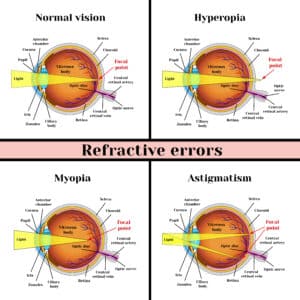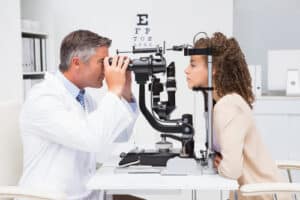Do you wear glasses or contact lenses? If you suffer from nearsightedness, farsightedness, or astigmatism, these are refractive errors.
They are also the most common eye conditions that you can have. These include nearsightedness, farsightedness, and astigmatism.
According to the National Eye Institute, about half of people in the United States have some refractive disorder. Thanks to the help of glasses or contacts, however, clear vision is possible. Keep reading to learn more about refractive errors and what causes them!
Understanding Refraction

Refraction refers to how light is focused inside the eye to transmit information to the brain. Specifically, the cornea and the lens in your eye bend light rays to focus them on the back of the eye, the retina.
The retina is made up of tissue with light-sensitive cells called photoreceptors. Photoreceptors are responsible for capturing images. A sharp image is then transmitted to the brain through the optic nerve.
When this doesn’t happen as it should, it can compromise the quality of your vision. Three anatomical structures of the eye are necessary for proper refraction to occur.
These include the length of the eyeball, the curvature of the cornea, and the curvature of the lens. When any of these are irregular, it results in a specific type of refractive error.
Nearsightedness
Also called myopia, nearsightedness means that you have difficulty looking at something that’s far away. Patients cannot see far away objects clearly.
These objects may include things like street signs or the board at school. However, they may still be able to perceive close-up objects well even though they struggle to see things that are far away from them.

If you’re nearsighted, you’ll typically first start to realize it during childhood or adolescence. Your family history can increase your chances of developing nearsightedness. Approximately a third of people have this refractive error.
Having an eye that’s an irregular shape can cause nearsightedness. If your eye is too long or the cornea is too steep, light cannot focus properly.
Instead of focusing on the back of the retina, light passes in front of it. When light passes in front of the retina, it makes distant images appear blurry. Additional symptoms can include squinting, fatigue, and eye strain.
Farsightedness

Hyperopia, or farsightedness, makes it difficult to see objects up close that are right in front of you. You may be able to read street signs, but you’ll struggle to clearly see the words in a book.
Some farsighted people get a headache when they try to perform a close-up activity like reading. Those who have farsightedness tend to develop an inability to read up close by the age of 40.
Most with farsightedness have it from birth. In rare cases, it can develop as a result of a disease. Like nearsightedness, it also has a genetic component, meaning you’re more likely to develop it if someone in your family has it. Farsightedness is incredibly common, as about 60 percent of the American population is affected by this refractive error.
In this case, the cause is often due to the eye being too short or the cornea being too flat. Consequently, the light rays focus behind the retina, and up-close images appear blurry. Closer objects require more focusing ability, making them blurrier.
Astigmatism
Astigmatism occurs when the cornea or lens of the eye is asymmetric. An asymmetric cornea or lens means that the eye is not entirely round.

The eye’s ability to focus light evenly becomes affected. When your eye is an irregular shape, light can get bent to the eye’s particular direction, making only one part of an image in focus.
Most people that have astigmatism are born with it, although the reason is unknown. It can develop from eye trauma or disease.
Contrary to popular myths, poor lighting while reading or sitting too close to the TV does not cause this refractive error. One in three people has some degree of astigmatism, making it very common.
With this type of refractive error, images can look blurry or shadowed. You may experience eye strain, headaches, or difficulty seeing at night.
It is common for people with astigmatism to have other refractive errors like nearsightedness or farsightedness.
Treating Refractive Errors

Your eye doctor can diagnose a refractive error through a simple but comprehensive eye exam. You will be asked to read an eye chart.
Your eye doctor will use a variety of tools such as a phoropter to evaluate your vision. Once your ophthalmologist has made an assessment, they will talk to you about your preferred vision correction method and prescribe glasses, contact lenses, or both.
A refractive error is usually corrected with glasses or contact lenses. When they are worn, you can see clearly at any range.

About 75 percent of adults use either type of vision correction. Some individuals choose a permanent vision correction procedure like LASIK. You must qualify as a candidate for the procedure before you can undergo it.
When you are nearsighted, your prescription is a negative number, such as -2.50. A strong lens equates having a prescription with a more negative number. If you’re farsighted, your prescription will indicate a positive number. If you have a higher number on your prescription, it will suggest that you have a stronger prescription.
For people that have presbyopia, many choose to use reading glasses. Other ways of treating this vision condition include contact lenses, laser vision correction, or special implant lenses.
If you have cataracts and presbyopia, there are various options available to remove cataracts and treat presbyopia simultaneously. Talk to your eye doctor about your options and find out their recommendations based on your visual goals and lifestyle needs.
Do you feel like your vision is lacking? If your eyesight seems like it’s blurry or distorted, it may be time to find out if you have refractive errors and need visual aids to see better.
Schedule an appointment at Takle Eye Group in Griffin, GA, to learn more!




